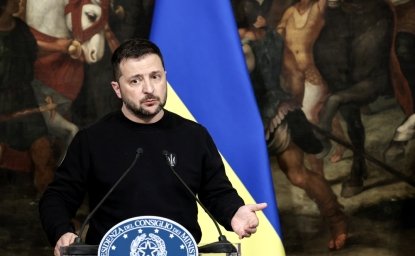
A blog of the Kennan Institute
The venerable Cleveland Orchestra invited Ukrainian conductor Oksana Lyniv to lead one of its Blossom Music Center concerts this summer. Lvniv, who was the first female music director of an Italian opera house (the Teatro Comunale di Bologna) and the first woman to conduct at Bayreuth, has promoted Ukrainian classical music tirelessly as she has become a leading candidate for several music director positions with major orchestras around the world.
Her July appearance in Cleveland featured Janáčk’s Cunning Little Vixen Suite, Sergei Rachmaninov’s Rhapsody on a Theme of Paganini, Igor Stravinsky’s The Firebird Suite, and Boris Lyatoshynsky’s Grazhya Symphonic Ballad. Lyniv’s presentation of Lyatoshynsky’s work won particular praise. Writing for the website Bachtrack, critic Frank Kuznik found this performance “a gripping narrative, colorful and exciting, bristling with the sounds of battle.” He continued, “For a visiting conductor to achieve that level of detail and visual quality in a one-off with the orchestra was truly remarkable.”
Lyniv’s previous accomplishments enabled her to feature Lyatoshynsky’s once obscure music. The composer’s works have remained largely unknown in the West before the current war prompted performances across Europe and North America. The Cleveland concert is but one of several bringing Ukrainian classical music—including that of Lyatoshynsky—into the mainstream symphonic repertoire worldwide.
Lyatoshynsky’s Soviet musical legacy poses challenges for reconstituting a Ukrainian musical tradition. Widely recognized as a leading member of the founding generation of 20th century Ukrainian composers, Lyatoshynsky was born in Zhytomyr in 1895 into a household steeped in Polish literature and history. He entered Kyiv University’s School of Law in 1913 before being employed to teach at the Kyiv Conservatory. He composed music in several genres throughout the 1910s. He entered the Soviet musical mainstream studying folk music and composing folk ballets in Tajikistan during the 1930s and joined the faculty of the Moscow Conservatory. He composed two operas, The Golden Ring and Shchors, during this period.
Lyatoshynsky began arranging Ukrainian songs while the Conservatory was in wartime exile in Saratov. He simultaneously worked to save Ukrainian musical manuscripts from destruction at the hands of the Nazis.
Following the war, he turned to composing symphonic works (including five symphonies, the Grazhyna, as well as his Taras Shevchenko and Romeo and Juliet suites, and a “Slavic” piano concerto). Soviet authorities banned some of his compositions, such as his Second Symphony, during the restrictive Stalinist years following World War II. Despite such flirtations with what Stalinist critics considered to be “formalism,” Lyatoshynsky received top accolades from the Soviet regime, including two Stalin Prizes.
Lyatoshynsky was named People’s Artist of the Ukrainian SSR the year of his death, 1968. He had become recognized by this time as one of the important promoters of modernism in Ukrainian classical music through his compositions and his teaching. Several of his students became leaders in the Kyiv avant-garde movement of the 1960s and 1970s. His efforts to integrate Ukrainian and Polish musical motifs into a 20th century European classical repertoire increasingly won praise from promoters of Ukrainian culture, despite his complex relationship with the Soviet government.
In January 2022, the Kyiv Symphony Orchestra established the Lyatoshynsky Club as a “community of passionate people from culture and business, aimed at discovering, multiplying and promoting Ukrainian music at home and abroad.” The club views its establishment as an effort to address the need to represent Ukrainian national art, “a large part of which remained unknown to the public due to the ideological vices of colonial policy.”
Lyatoshynsky was a Soviet composer whose compositions, teaching, and preservation efforts helped a Ukrainian classical music canon to emerge. He represents numerous cultural figures who built careers during the Soviet period and nurtured the conditions for a modern, post-Soviet Ukrainian culture to coalesce following independence. His music demonstrates the ways in which identifying creative artists as “Soviet” obscures as much of their legacies as it clarifies.
This summer’s concert in Ohio placed Lyatoshynsky’s symphonic work among other well-known “Slavic” composers such as Janáčk, Rachmaninov, and Stravinsky. Such attention—especially at the masterful hands of conductor Lyniv and one of the world’s top symphonies, the Cleveland Orchestra—opens ears to a Ukrainian classical tradition hidden for too long behind labels like “Soviet” and “European.”
The opinions expressed in this article are those solely of the author and do not reflect the views of the Kennan Institute.
Author

Former Wilson Center Vice President for Programs (2014-2017); Director of the Comparative Urban Studies Program/Urban Sustainability Laboratory (1992-2017); Director of the Kennan Institute for Advanced Russian Studies (1989-2012) and Director of the Program on Global Sustainability and Resilience (2012-2014)

Kennan Institute
The Kennan Institute is the premier US center for advanced research on Eurasia and the oldest and largest regional program at the Woodrow Wilson International Center for Scholars. The Kennan Institute is committed to improving American understanding of Russia, Ukraine, Central Asia, the South Caucasus, and the surrounding region though research and exchange. Read more

Explore More in Focus Ukraine
Browse Focus Ukraine
Building a Thriving Ukrainian Design Community Now

Ukraine Seeks to End the War. What's Wrong With the “Peace Scenarios”?


